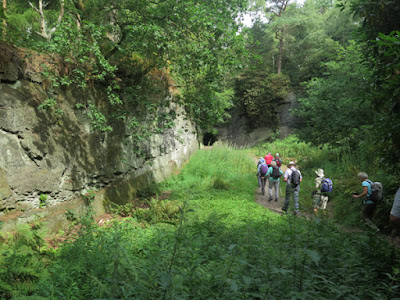 |
| The Sheffield U3A Geology Group on Stormy Point at Alderley Edge |
During the Sheffield U3A Geology Group trip to Alderley Edge, the whole morning was spent examining Church Quarry in detail but, after lunch, the group set off to explore several other sites that relate to its history of mining.
 |
| A scar left by mining along the Engine Vein |
The first stop off point was to see the mine workings along the Engine Vein, which date back to the Bronze Age. The site is fenced off and it is not possible to look closely at the Helsby Sandstone, which contains most of the minerals here that consist of widespread occurrences of barytes and more localised copper-dominated polymetallic ore deposits; however, it is possible to see green coloured staining from the mineral malachite, which once appeared at the surface.
We then moved on to Stormy Point, an open space in the woodland where a large area of bare rock is exposed and which provides a good opportunity to examine the geology in some detail.
 |
| A view towards the Peak District National Park from Stormy Point |
The mineralisation is considered to be the result of the percolation of low temperature saline fluids through the porous Helsby Sandstone, with the faults in the region acting as conduits and also being associated with the concentration of minerals as veins.
 |
| An excavated mineral vein at Stormy Point |
One of these mineral veins has been clearly excavated here and, although these have been worked out by generations of miners over the years, blue azurite and malachite can still be found in the rock fragments and barytes occurs as veins and clots in the bedrock here.
 |
| Veins and clots of barytes at Stormy Point |
Although the bedrock at Stormy Point essentially comprises conglomerate, in places these are underlain by beds of marl with green/red colouration, which are differentially weathered to leave the conglomerate standing proud.
 |
| Triassic conglomerate and marl with a £1 coin used for scale |
After a brief investigation of other worked out mineral veins that are associated with faulting, we had a brief look at the large Old Alderley Quarry. Although the quarry faces were not readily accessible, from a distance a thick bed of marl is clearly distinguished from the sandstone above and below it – being differentially weathered to leave a deep linear scar in the quarry face.
 |
| A view of the Old Alderley Quarry |
The trip finished with an exploration of the area to the west of the B5027 road, to see one of the old minerals processing areas - where the land is still poisoned by the chemicals used in the extraction of the metals – and various capped old shafts and adits that are the only remains of the mining industry, which finished here in 1919.
 |
| An old adit |
As I had previously discovered with previous trips by myself to the Porter Valley and Ecclesall Woods, the industrial archaeology didn’t interest me that much – although I think that I would appreciate it much more if taking part in one of the organised visits down one of the old mines, arranged by the Derbyshire Caving Club; however, as a professional geologist, I won’t complain because I am a little bit wiser and my collection of rocks has increased significantly.
 |
| Various rocks collected from Alderley Edge |


















